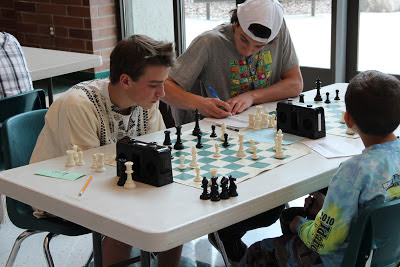 |
| 2012 Fall "Turkey Shoot" Tournament |
The Fall
"Turkey Shoot" chess tournament was a lesson in tie-breaks and
heartbreaks. Twenty students competed on
Saturday, November 17 in hour-long games in a five round tournament. The elementary sections played eight rounds
due to the fast pace of their games.
 |
| A great day for a tournament with a view down Croy Canyon. |
 |
| Jacob plays Anna in the first round. |
 |
| Des gets ahead in points and pawns, but neglects the back rank and Jacob pulls out a surprise attack! |
 |
| "I took the pawn and blundered the game away!" says Des. |
 |
| Riley has a fierce opening game as she begins the middle game a piece up. |
 |
| Most Inspirational Elementary Player, Collin |
Tie-breaks
were necessary in each of the sections and are determined using mathematical
algorithms that calculate a number based on the difficulty of the opponents
faced by each player. In the Kindergarten through 3rd grade section, Darwin
Porth won first place with 6.0 points and Quentin Van Law won second place with
6.0 points. Tie-breaker points
determined the outcome. Luke Baker (4.5
pts.) won third place. In the 4th and
5th grade section, Alex Baker and Walter Kriesien tied for first with 6.5
points, but Alex Baker won first on tie-breaker points. Zane Barckholtz won third place with 6.0
points. Medals were awarded to all other
players in the elementary section.
 |
| Rileys only loss was against Desmond. |
Tie-breaker points are calculated in a number of different ways and the totals of each are compared and cascade until a result is obtained. There are over 18 different ways of calculating tie-breaker points and I thank the lord for WinTD and pairing software for calculating all this. Here are the common tie-breakers used in tournaments around the U.S. and the ones that I select for local tournaments:
1st Tie Break - Head-to-Head
Determine if one of the players beat the other from cross table. As my friend Barry Eacker and I agree that this is one of the best means of calculating tie breaks.
2nd Tie Break - Modified Median
The sum of all opponent's scores with the highest and lowest scoring opponent discarded. Additionally, players > 50% have only their lowest scoring player discarded, players < 50% have only their highest player discarded, with = 50% handled as the Median System.
3rd Tie Break - Solkoff
The sum of all opponent's scores with no scores discarded.
4th Tie Break - Cumulative
To calculate this, sum the running score for each round. For
example, if a player has (in order) a win, loss, win, draw,
and a loss; his round-by-round score will be 1, 1, 2, 2½, 2½. The sum of these
numbers is 9. This system places more weight on games won in the early rounds
and the least weight on games won in the final rounds. The rationale for this
system is that a player who scored well early in the tournament has most likely
faced tougher opponents in later rounds and should therefore be favored over a
player who scored poorly in the start before subsequently scoring points against
weaker opponents.
5th Tie Break - Cumulative of Opposition
This is the total of the opponent's cumulative score.
How do Byes figure into all this tie-breaking business?
Let me explain by sharing an example from this past weekend. If a player scores four points by beating four opponents, and another one scored four points but one of the points was from a bye, then who should win the higher placement? The person that won four games, or the one that beat only three opponent's.
Many students love to get a "bye" for some reason and my experienced
players in the club now recognize that byes do not help in tie-breaks and they
do not like them. After all, players enter tournaments to play and not
"please wait."
As indicated, tie-breakers can be tear-jerkers and heart-breakers. Especially, when the prize is a trophy because tie-breakers are used to determine the placements. If it is a cash prize, the money is combined and divvied up equally. Calculating the results and trying to explain to the parents and the pint-size players why their top score is second to the other same score is stressful. But, with tournament experience, the tie-breaking system will eventually make sense to those that stick with tournaments and they are less of a surprise.
 |
| Dylan and Anna play while Matt, Wyatt, and Terry watch |
How do Byes figure into all this tie-breaking business?
Let me explain by sharing an example from this past weekend. If a player scores four points by beating four opponents, and another one scored four points but one of the points was from a bye, then who should win the higher placement? The person that won four games, or the one that beat only three opponent's.
 |
| Ipads and Tablets entertain players in between rounds. |
As indicated, tie-breakers can be tear-jerkers and heart-breakers. Especially, when the prize is a trophy because tie-breakers are used to determine the placements. If it is a cash prize, the money is combined and divvied up equally. Calculating the results and trying to explain to the parents and the pint-size players why their top score is second to the other same score is stressful. But, with tournament experience, the tie-breaking system will eventually make sense to those that stick with tournaments and they are less of a surprise.
Tyler Avila totes his turkey
 |
| Brother and sister face off. |






No comments:
Post a Comment